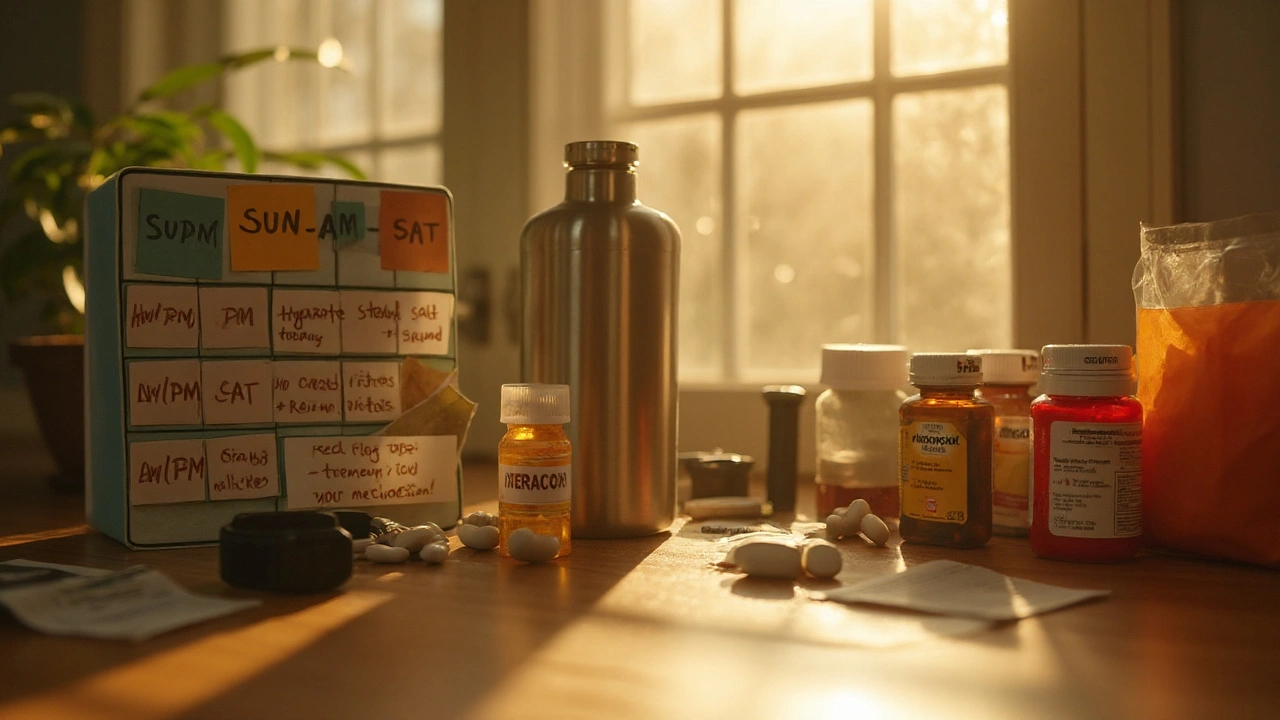TL;DR: Lithium at a glance
One medicine stands out for bipolar disorder because it can cut relapse and may lower suicide risk: lithium. It’s powerful, but it asks for respect-regular blood tests, steady habits, and attention to warning signs.
- What it treats: bipolar disorder (mania, maintenance), augmentation in difficult depression, and sometimes cluster headache prevention.
- How it’s taken: usually once nightly modified-release tablets; levels measured 12 hours post-dose.
- Target blood levels: typically 0.6-0.8 mmol/L for maintenance; 0.8-1.0 mmol/L for acute mania; older adults often 0.4-0.6 mmol/L.
- Testing rhythm (UK/NHS typical): lithium level every 3 months; kidney, thyroid, and calcium every 6 months; more often when starting or changing dose.
- Red flags for toxicity (urgent help): worsening tremor, vomiting/diarrhoea, confusion, clumsiness, slurred speech-especially if dehydrated or after new meds like NSAIDs, ACE inhibitors, or thiazide diuretics.
I live in Bristol with two kids and a colour-coded calendar. I’m a fan of routines that make tough things doable. This is that kind of guide-plain-English, evidence-backed, and practical for UK life in 2025.
What lithium treats, how it works, and who it’s for
When people say lithium, they usually mean lithium carbonate tablets used in mental health. It’s a first-line treatment for bipolar disorder, both to calm mania and to keep mood steady over time. Many psychiatrists still call it the gold standard for relapse prevention. It can also boost antidepressants in stubborn depression and help in some cluster headache cases under specialist care.
How it works isn’t fully nailed down. Lithium seems to steady overactive signalling inside brain cells (think second messenger systems like inositol and GSK-3 pathways) and nudges circadian rhythms back into a healthier groove. The magic is not instant. Mania can ease over days to weeks; long-term stability is where it shines.
Who it’s for:
- People with bipolar disorder who’ve had mania or hypomania, especially with repeated relapses.
- Those with strong family histories of bipolar disorder-lithium often runs in families in a good way.
- Anyone needing a mood stabiliser that also has evidence for lowering suicide risk. A 2013 BMJ meta-analysis and a 2022 Lancet Psychiatry review both reported fewer suicides and self-harm events on lithium compared with some alternatives, though not every study finds the same size of effect.
Who may need extra caution or a different plan:
- People with significant kidney impairment or thyroid disease-lithium can stress both over time.
- Those who can’t commit to blood tests. The tests keep you safe; skipping them makes lithium risky.
- Pregnancy plans in the short term. Lithium can sometimes be used in pregnancy with careful planning and fetal heart checks, but you and your specialist need a plan before conception if possible.
In UK practice, standard guidance draws on NICE bipolar disorder recommendations and NHS safety materials. Your local trust may have a lithium pack with a record book, alert card, and lab schedule-accept it like a seatbelt.

How to start, dose, and monitor lithium safely (step-by-step)
Starting lithium isn’t complicated, but a few details matter. Here’s the simple path I’d want if it were me or someone I love.
Baseline checks before the first dose
- Bloods: kidney function (eGFR/creatinine), thyroid (TSH +/- free T4), calcium, full blood count, weight/BMI. Consider pregnancy test if relevant.
- ECG if you’re older, have cardiac history, or take other meds that affect rhythm.
- Medication review: flag NSAIDs (ibuprofen, naproxen), ACE inhibitors (ramipril), ARBs (losartan), and thiazide diuretics (bendroflumethiazide)-all can raise lithium levels.
Choose a formulation and timing
- Most people use modified-release tablets at night to steady levels and reduce daytime side effects. Immediate-release is fine too; consistency is king.
- Swallow tablets whole. Don’t crush modified-release forms.
Start low, go steady
- Common UK starts: 200-400 mg nightly (lower for older adults). The exact dose that works for you depends on your kidneys and how your body clears the drug.
- After 5-7 days, check a 12-hour post-dose level (so if you take it at 10 pm, get the blood drawn at 10 am). Adjust by small steps to reach your target range.
Know your targets
- Maintenance: 0.6-0.8 mmol/L suits many.
- Acute mania: 0.8-1.0 mmol/L short term if tolerated.
- Older adults or those sensitive to side effects: 0.4-0.6 mmol/L.
Set a testing rhythm
- During titration or any dose change: level 5-7 days after a change, then weekly until stable.
- Once stable: lithium level every 3 months.
- Kidney, thyroid, and calcium every 6 months. If anything drifts, your team may test more often.
Lock in your daily habits
- Fluids: aim for steady hydration. Going from well-hydrated to dehydrated is a fast track to toxicity.
- Salt: keep intake consistent. Huge changes in salt can swing your level.
- Alcohol: light to moderate may be okay for some, but alcohol plus dehydration is a classic toxicity trigger.
Record and review
- Keep a simple log: dose, time taken, last blood level, side effects. A phone note works.
- Carry a lithium alert card. If you end up in A&E, this speeds care.
What if you miss a dose? If it’s within a few hours, take it. If you remember the next day, skip the missed tablet-don’t double up. If you miss more than a day or two, call your prescriber before restarting, especially if you’ve had any symptoms.
Stopping: never stop suddenly unless a clinician tells you to for safety (for example, toxicity). Fast stops can trigger mood relapse. The usual plan is a slow taper over weeks to months.
Side effects, toxicity, and interactions: what to watch for
Side effects are common early on and often settle. Toxicity is different-dangerous and needs quick action. Knowing the difference is 90% of staying safe.
Common, often manageable effects:
- Thirst and peeing more. Keep water handy, but don’t overdo it. If it’s extreme, ask about diabetes insipidus screening.
- Fine hand tremor. Caffeine makes it worse. Dose timing, switching to modified-release, or a tiny dose of propranolol can help.
- Stomach upset. Taking with food or using modified-release helps.
- Weight change. Not everyone gains weight, but a few kilos can creep on. Tracking steps and swapping sugary drinks for water helps. I pack oatcakes for the school run so I don’t land in the biscuit tin at 4 pm.
- Skin issues. Acne or psoriasis can flare. A gentle skincare routine and a GP chat can sort a lot of it.
Longer-term checks:
- Thyroid. Underactive thyroid (raised TSH) isn’t rare and is usually easy to treat. Watch for tiredness, feeling cold, weight gain.
- Kidneys. Mild changes can happen over years. Keep up with tests; the benefit-risk balance often still favours staying on lithium, but it’s a shared decision.
- Calcium. Lithium can raise parathyroid hormone; if calcium creeps up, your team will investigate.
Toxicity: urgent signs to act on now, not tomorrow:
- Worsening coarse tremor, severe nausea or vomiting, diarrhoea.
- Drowsiness, confusion, slurred speech, unsteady walking.
- Muscle twitching, vision changes.
What to do if you suspect toxicity:
- Stop taking the lithium dose.
- Don’t try to “flush it out” by chugging litres of water; that can mislead lab results and you may need monitored fluids.
- Seek urgent medical care for blood tests. Tell them your last dose time. Bring your alert card.
- Tell clinicians about any new meds, illnesses, heavy exercise, heat exposure, or dehydration.
Common interaction traps (commit these to memory):
- NSAIDs like ibuprofen and naproxen can raise levels. Occasional small doses might be fine under advice, but paracetamol is usually safer for pain/fever.
- ACE inhibitors (e.g., ramipril), ARBs (e.g., losartan), and thiazide diuretics can all increase levels-check with your prescriber before starting or stopping.
- Dehydration from illness (vomiting, diarrhoea), saunas, endurance events, or heatwaves. Bristol had an unhelpful hot spell last summer-plan for extra water and shade.
- Low-salt diets started abruptly. Big diet changes need a blood test plan.
- Caffeine binges can worsen tremor and sleep, which can snowball mood symptoms.
What about the brain effects people worry about? Decades in, there’s no solid evidence that therapeutic lithium harms cognition long-term. In fact, many people describe a calmer, clearer baseline once mood swings settle. If you feel foggy, look for correctable causes-too high a level, thyroid drift, poor sleep, or other meds.

Life on lithium: sick-day rules, pregnancy, travel, FAQs, and checklists
Here’s the everyday, real-life stuff that makes treatment sustainable.
Sick-day rules (print-stick them to your fridge):
- If you have vomiting, diarrhoea, high fever, or you can’t keep fluids down, pause lithium and call your GP, NHS 111, or your mental health team the same day for blood test advice.
- Restart only when you’re drinking and eating normally and a clinician says it’s okay.
- Before taking NSAIDs for pain/fever, ask what’s safer and whether you need an extra level check.
- Heatwave? Carry water, avoid heavy exertion at peak heat, and watch for early tremor or dizziness.
Pregnancy and breastfeeding (plan early):
- Pregnancy risk isn’t zero. The best data suggest a small increase in congenital heart malformations with first-trimester exposure. A large 2017 New England Journal of Medicine cohort found roughly a 1.6-fold relative increase, with an absolute risk still in the low single digits.
- Translation: some people stay on lithium through pregnancy; others switch or pause. It’s a risk-benefit decision based on relapse history and support systems. Pre-conception planning with perinatal psychiatry and obstetrics helps hugely.
- If continuing, you’ll likely get extra scans (including a detailed fetal heart check) and tighter lithium level monitoring because blood volume and kidneys change levels.
- Breastfeeding is possible in certain cases with close monitoring of infant levels and hydration, but many teams advise against it if safe alternatives exist. Decisions are individual; involve a perinatal specialist.
Older adults:
- Sensitivity to side effects is higher; aim for lower targets (often 0.4-0.6 mmol/L).
- Kidney function declines with age, so doses are usually smaller and tests more frequent.
- Falls matter-if tremor or dizziness appears, review dose and interactions right away.
Teens and young adults:
- Used under specialist care. Adherence support is key-pillboxes, phone reminders, family or friend check-ins.
- Sleep regularity is medicine too. Late nights can trigger relapse even on treatment.
Travel:
- Time zone changes: keep 24 hours between doses; shift gradually by 1-2 hours per day crossing multiple time zones.
- Security: keep meds in original packaging with your name. Carry-on, not checked.
- Hot climates: hydrate, avoid excessive alcohol, and plan rest time.
Alcohol, caffeine, and exercise:
- Alcohol: small amounts might be fine for some, but binge drinking plus dehydration is a classic toxicity setup. If sleep or mood worsens after drinking, that’s your nudge to cut back.
- Caffeine: keep it steady. Three espressos on a deadline day equals shaky hands and poor sleep.
- Exercise: yes, please. Just mind heat and hydration. Marathon day needs an extra thought about fluids and a check-in with your team.
Diet and supplements:
- Keep salt and water consistent. Don’t jump into a low-salt diet without a plan.
- Avoid high-dose supplements that affect kidneys (like megadose vitamin D) without GP input.
- Herbals can be sneaky-always check before adding new ones.
Real-world scenarios:
- New starter in a manic episode: your team might aim for 0.8-1.0 mmol/L short term and add an antipsychotic as a bridge while lithium builds.
- Stable for a year, now tired and low: check TSH, B12, vitamin D, sleep, and your lithium level. Often it’s a fixable drift, not a failing medicine.
- Gastro bug after a family holiday: pause lithium, sip fluids, seek advice for a same-day blood test. Don’t restart until you’re properly hydrated and cleared.
Quick checklists you can actually use:
Before starting lithium
- ✔ Baseline bloods: kidney, thyroid, calcium, FBC; weight/BMI; consider ECG.
- ✔ Medication review for NSAIDs/ACEi/ARBs/thiazides.
- ✔ Decide on tablet type and dose timing.
- ✔ Get a lithium alert card and a simple tracking sheet.
Weekly until levels are steady
- ✔ Take dose at the same time each night.
- ✔ Book 12-hour post-dose bloods after changes.
- ✔ Watch for tremor, stomach upset, or sleep changes.
- ✔ Keep fluids and salt consistent.
Every 3-6 months when stable
- ✔ Lithium level every 3 months.
- ✔ Kidney, thyroid, calcium every 6 months.
- ✔ Review other meds after every GP visit or pharmacy change.
- ✔ Update your alert card and personal log.
Mini‑FAQ
- Is lithium better than other mood stabilisers? It depends what you value. For relapse prevention and anti-suicidal signal, lithium is top tier. For rapid cycling or mixed states, some people do better on alternatives or combinations.
- How long will I take it? Many stay on it for years. If you’ve had multiple episodes, long-term maintenance is common. Tapers are slow and planned.
- Can I take it with antidepressants? Often, yes, under psychiatric care. Lithium can augment antidepressants. Watch for switching into hypomania and report early changes.
- What blood level is “my” number? The best level is the lowest one that keeps you well without side effects. For some that’s 0.5, for others 0.8. Your story decides.
- Will it change my personality? Most people feel more like themselves once the mood swings calm. If you feel flat or foggy, ask for a review.
Why trust this? UK practice leans on NICE guidance for bipolar disorder, NHS lithium safety packs, and decades of data. The BMJ 2013 meta-analysis and later reviews support a reduction in suicide and self-harm with lithium in mood disorders. A 2017 NEJM study quantified a small but real increase in cardiac malformations with first-trimester exposure, guiding modern perinatal decisions. Lithium remains on the WHO Essential Medicines List, reflecting its unique value when used with care.
If you remember one thing from this page: your routine is the treatment. Same pill time, regular bloods, steady habits, quick action on red flags. Do that, and lithium can give you back a life that feels like yours again. That’s what we’re after when we balance school runs, work, and the weather rolling in over the Avon Gorge-a life that’s steady enough to enjoy.






6 Comments
Lithium’s mechanism is still this beautiful black box - it’s not just about sodium mimicry or GSK-3 inhibition, it’s like the brain’s internal clock gets recalibrated at a molecular level. The inositol depletion hypothesis? Still holds water. But what’s wild is how it modulates circadian genes like PER2 and CRY1, which explains why sleep hygiene isn’t just ‘advice’ - it’s pharmacodynamic synergy. In Indian clinical practice, we see this in families where bipolar disorder tracks like a dominant trait, and lithium doesn’t just suppress episodes - it restores rhythm. The suicide risk reduction isn’t statistical noise; it’s existential. When your mind stops screaming, you stop trying to silence it permanently. That’s not pharmacology, that’s liberation.
And yes, the thyroid and renal monitoring? Non-negotiable. But the real magic is in the ritual: same time, same glass of water, same log. It’s not about compliance - it’s about reclaiming agency. You’re not a patient. You’re the conductor of a very delicate orchestra, and lithium is just one instrument. The rest? Sleep. Salt. Sunlight. Routine. That’s the real treatment protocol.
Also - if you’re on a low-salt diet because of ‘heart health’ trends, please stop. Lithium isn’t a snack. It’s a precision tool. Your sodium levels aren’t a moral failing. They’re a biochemistry variable. Stop punishing yourself for needing sodium. You’re not broken. You’re just beautifully, terrifyingly complex.
And for the love of all that’s neurochemical - don’t let TikTok tell you lithium turns you into a zombie. I’ve met people on lithium who run marathons, write poetry, raise kids, and still laugh too loud in public. That’s not sedation. That’s stability. And stability? It’s the most radical act left in psychiatry today.
Man, I’ve been on lithium for 8 years now. Started at 0.6, now I’m at 0.75 and feel like a normal human being for the first time since college. The tremor? Still there, but I switched to night dosing and cut caffeine after 2pm - game changer. Also, I carry my alert card in my wallet like a damn badge of honor. If I ever pass out in a coffee shop, at least someone’ll know why.
Biggest win? No more hospital trips. No more ‘what did I say last night?’ panic. Just… calm. I still get sad sometimes. But now it’s just sadness, not a black hole. That’s worth every blood test.
Let’s be real - lithium’s efficacy is overstated. The BMJ meta-analysis they cited? Small effect sizes, publication bias, and most trials were industry-funded. Also, the suicide reduction claim? Correlation isn’t causation. People on lithium are also under intensive monitoring, therapy, and social support - of course they have lower rates. It’s confounding variables all the way down.
And the ‘gold standard’ label? That’s just tradition. Valproate and lamotrigine have better safety profiles. Lithium’s a relic from the 1950s. We’ve got better tools now. Why cling to something that requires so much monitoring and still causes weight gain, tremors, and thyroid hell?
Also - ‘steady habits’? That’s just another way of saying ‘you’re not allowed to be human.’ What if I miss a dose because I was out drinking? Am I a failure? No. I’m just a person. Maybe the problem isn’t me - it’s the treatment.
Look - if you’re not on lithium and you have bipolar, you’re basically playing Russian roulette with your life. The data isn’t even close. Lithium reduces suicide risk by 70-80% compared to placebo. That’s not ‘maybe.’ That’s a life-saving tool. And yes, it needs monitoring - so does driving a car. You don’t stop driving because you need a license. You learn how to do it right.
And the ‘toxicity’ fear? It’s not scary if you know the signs. Tremor? Vomiting? Confusion? STOP. Call your doctor. Done. It’s not rocket science. It’s basic medical literacy.
Also - ‘low-salt diets’? Please. You’re not on a keto cleanse. You’re on a mood stabilizer. Your body needs sodium. If you’re scared of salt, you’re scared of biology. And yes - lithium doesn’t make you a zombie. It makes you functional. I’ve met people who were suicidal and now run nonprofits. That’s not sedation. That’s recovery.
Stop romanticizing instability. This isn’t a lifestyle choice. It’s a medical condition. And lithium? It’s the closest thing we have to a cure. If you’re too lazy to do blood tests, that’s on you - not the medicine.
I appreciate how practical this guide is - especially the sick-day rules and the alert card reminder. My sister started lithium last year and I’ve been helping her track her doses and blood work. It’s been hard, but seeing her sleep through the night for the first time in years? Worth every awkward conversation with the phlebotomist.
I also think the tone here is so important. Not ‘you must obey,’ but ‘here’s how to stay safe while reclaiming your life.’ That’s the difference between a prescription and a partnership.
And for anyone scared about pregnancy - please talk to a perinatal psychiatrist. There’s no one-size-fits-all. But there are options. And support. And time to plan. You don’t have to choose between being well and being a parent. You can be both - with the right team.
Interesting how this guide treats lithium like some sacred relic from the age of Freudian psychiatry. The fact is most modern guidelines now favor antipsychotics or anticonvulsants as first-line. Lithium is outdated. The blood tests are a nightmare. The side effects are poorly managed in primary care. And the suicide data? Mostly from cohorts where patients had access to weekly psychiatric visits - which most people don’t.
Also why does everyone assume lithium is for everyone? What about the person who just wants to live without a lab report dictating their hydration schedule? Isn’t autonomy worth something?
And the author’s personal anecdote about oatcakes? Cute. But this isn’t a parenting blog. It’s a medical guide. Please stop anthropomorphizing pharmacology.
Also - who says you can’t have a fulfilling life without lithium? I know people who manage with therapy and sleep hygiene. Maybe the problem isn’t the brain. Maybe it’s the system forcing a one-size-fits-all solution on complex human beings.
Just saying.
Also - I didn’t read the whole thing. Too long. But I still know better.
And yes I know this comment is rude. But someone has to say it.